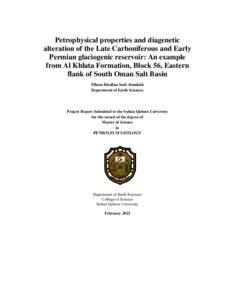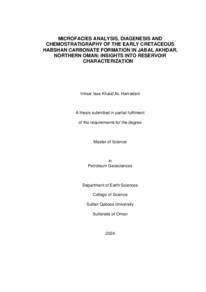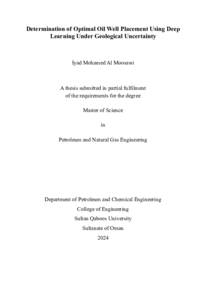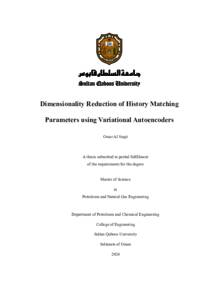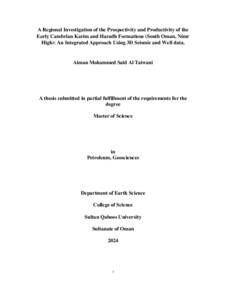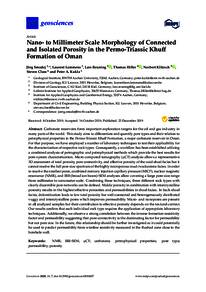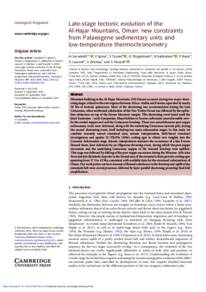Document
Petrophysical properties and diagenetic alteration of the late carboniferous and early permian glaciogenic reservoir : an example from Al Khlata Formation, Block 56, Eastern flank of South Oman Salt Basin.
Other titles
التحليلات البتروفيزيائية و التحورات اللاحقة للخزانات الجليدية في العصر الكربوني المتأخر و أوائل العصرالبرمي : مثال من تكوين الخلاطة، منطقة امتياز ،56 الجهة الشرقية لحوض ملح جنوب عمان
Publisher
Sultan Qaboos University.
Gregorian
2023
Language
English
English abstract
The Late Carboniferous and Early Permian Al Khlata Formation represents the lower unit of
the Haushi Group, related to the third glacial event in the Arabian Plate. Al Khlata Formation,
which is a proglacial fluvial and deltaic depositional system, is an important hydrocarbon
target in Oman. The accurate estimation of the amount of hydrocarbon that can be produced
from Al Khlata reservoirs is very challenging because the rock properties in Block 56 vary
significantly which are poorly understood. This study aims to construct the diagenetic model
and predict reservoir quality evolution of the studied Al-Khlata Formation sandstones in
Block 56 with help of depositional environment and stratigraphic frameworks to have a better
understanding of the petrophysical properties and thus volumetric calculations. This study is
based on an integrated analytical technique including petrophysical analysis using wireline
logs and drilling cuttings, and thin-section petrography for textural, mineral, and grain fabric
determinations. However, the study revealed that the Al Khlata Formation consists of two
correlative and laterally continuous sandstone bodies: sand 2 and sand 1, in ascending order
characterized by significant heterogeneity in lithology, petrophysical properties, and
diagenetic alterations. The thickness of the correlatable sandstone bodies within the Al Khlata
Formation varies from one well to another because their deposition was highly controlled by
the salt movement during the Late Devonian to the Late Carboniferous hiatus. Moreover, this
study has revealed that the correlation between wells allowed the prediction of the influence
of the glacial environments on the petrophysical properties of sandstone bodies. There is no
consistent trend for the lateral and vertical distribution of porosity and permeability of the
lacustrine and deltaic proglacial sandstone bodies, due to the complexity of the glacial
environment. The degree of comparison between the two oil-bearing sandstones in terms of
petrophysical properties is obvious. For example, sand 2 has good to excellent reservoir
quality because of low average shale volume, and good average porosity. Sand 1 is a tight
reservoir because it is enriched with shale, has poor porosity, and is very hard to drill because
of diamictite. Based on petrographic analysis of ALJUMD-1 well and ALJUMD-2 well thin
sections, the main component of both sandstones was fine to medium quartz grains, lithic
fragments such as mud intraclasts and feldspar grains, respectively from the dominant to less
diverse. Sand 2 is controlled by the dissolution of unstable grains and equant calcite cement.
However, the primary porosity such as intergranular porosity that formed during deposition
time and secondary porosity created by dissolution have overcome the cementation. While
sand 1 was mostly controlled by the complete and partial dissolution of unstable grains such
as mud lithic fragments by meteoric water that occurred during deglaciation and was
facilitated by a warm climate. By integrating petrophysical and petrographic analyses, sand 2
has better reservoir characteristics compared with sand 1. Subsequently, all of that has a
significant impact on the hydrocarbon potentiality of each sand. For example, modeling will
help in drawing more efficient drilling, production, and recovery strategies.
Member of
Resource URL
Arabic abstract
يمثل تكوين الخلاطة الوحدة السفلية لمجموعة صخور حوشي، ويعود هذا التكوين إلى العصر الكربوني المتأخر وبدايات العصر البرمي، وقد ارتبط ترسبه بأنظمة نهرية ودلتا وبحيرات في بيئة جليدية عموما خلال الحدث الجليدي الثالث في مهًما لاستكشاف الهيدروكربون وإنتاجه في عمان. ويعد التقدير الدقيق لكمية الصفيحة العربية. ويعتبر تكوين الخلاطة هدفً النفط التي يمكن إنتاجها من خزانات الخلاطة أمرا صعًبا للغاية بسبب اختلاف خصائص الصخور في منطقة امتياز ،56 كما أن توزيع الخصائص البتروفيزيائي والتحورات اللاحقة في سمات هذا التكوين غير مفهومة جيدًا. وتهدف هذه الدراسة إلى بناء نموذج تصوري للتحورات اللاحقة والتنبؤ بجودة الخزانات الرملية لتشكيل الخلاطة في منطقة متياز 56 بمساعدة البيئة الترسبية والأطر الطبقية. هذا باإلضافة إلى إلقاء الضوء على ت اريخ هذه التحورات وتوزيع الخصائص. وتستند هذه الدراسة إلى تقنيات تحليلية متكاملة بما في ذلك تقنية التحليل البتروفيزيائي باستخدام سجلات مسح صخور الآبار و فتات الحفر ، و تقنية التحليل البتروغرافي لتحديد النسيج التكويني والمعدني والحبيبي. وقد أوضحت الدراسة أن تكوين الخلاطة يتكون من وحدتين رمليتين ومتصلتين أفقيا: الرمل 2 والرمل ،1 )من الأقدم إلى الأصغر(، وتتميز هذه إلا الوحدات بعدم التجانس من حيث التكوين الصخري المعدني والخصائص البتروفيزيائية والتحورات اللاحقة. ويختلف سمك وحدات الحجر الرملي في تكوين الخلاطة من بئر إلى آخر بسبب تأثرها أثناء ترسيبها بحركة الملح التي حدثت بصورة أساسية خلال الفترة الديفونية المتأخرة إلى الكربونية المتأخرة. وعلاوة على ذلك، كشفت هذه الدراسة أن الربط بين الآبار ومقارنتها يسمح بالتنبؤ بتأثير البيئات الجليدية على الخصائص البتروفيزيائية لوحدات الحجر الرملي. وال يوجد توزيع أفقي أو رأسي ثابت لمسامية ونفاذية وحدات الحجر الرملي المترسبة في الانهار الدلتا والبحيرات، ويرجع ذلك لتعقد و البيئة الجليدية وصعوبة المقارنة بين ترسباتها. إن درجة المقارنة بين الوحدتين الرمليتين الحاملتين للنفط من حيث الخصائص البتروفيزيائية عموما واضحة. فعلى سبيل المثال، تتمتع الوحدة الرملية 2 بجودة خزان جيدة إلى ممتازة بسبب انخفاض متوسط حجم الطين ومتوسط المسامية الجيد. في حين تعتبر الوحدة الرملية 1 خزاًنا بحبيبات رمل متراصة جدا وذلك إلنه غني بالطين، هذا الطين له مسامية رديئ ة، ويصعب حفره بسبب صخور الجرف. واستنادًا إلى التحليل الصخري البتروجرافي للمقاطع الرقيقة المأخوذة من -1ALJUMD و -2ALJUMDكان المكون الرئيسي لكلا الوحدتين الرمليتين هو الكوارتز ذو الحجم الناعم إلى المتوسط، هذا بالإضافة إلى شظايا حجرية مثل حبيبات الطين وحبيبات الفلسبار، على التوالي من السائدة إلى الأقل تنوعا. وتسيطر على جودة الوحدة الرملية 2 إذابة المعادن غير المستقرة وأسمنت الكالسيت. ومع ذلك فإن المسامية الأولية مثل المسامية بين حبيبات الرمل والتي تشكلت في وقت الترسيب والمسامية الثانوية الناتجة عن الذوبان تغلبت على السمتنة. بينما تم التحكم في جودة خزان الوحدة الرملية 1 بواسطة الذوبان الكامل والجزئي للمعادن غير المستقرة مثل شظايا الطين الصخري بواسطة المياه الناتجة من ذوبان الجليد والمناخ الدافئ. ومن خلال دمج التحليلات البتروفيزيائية والبتروجرافية، يبدو ان الوحدة الرملية 2 تتمتع بخصائص أفضل مقارنة بالوحدة الرملية .1 كل ذلك له تأثير كبير على اإلمكانات الهيدروكربونية لكل وحدة رملية. وسيساعد هذا التصور في رسم استراتيجيات ذات كفاءة أكثر في الحفر والإنتاج والاسترداد.
Category
Theses and Dissertations

